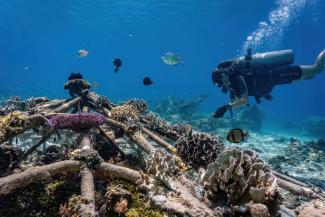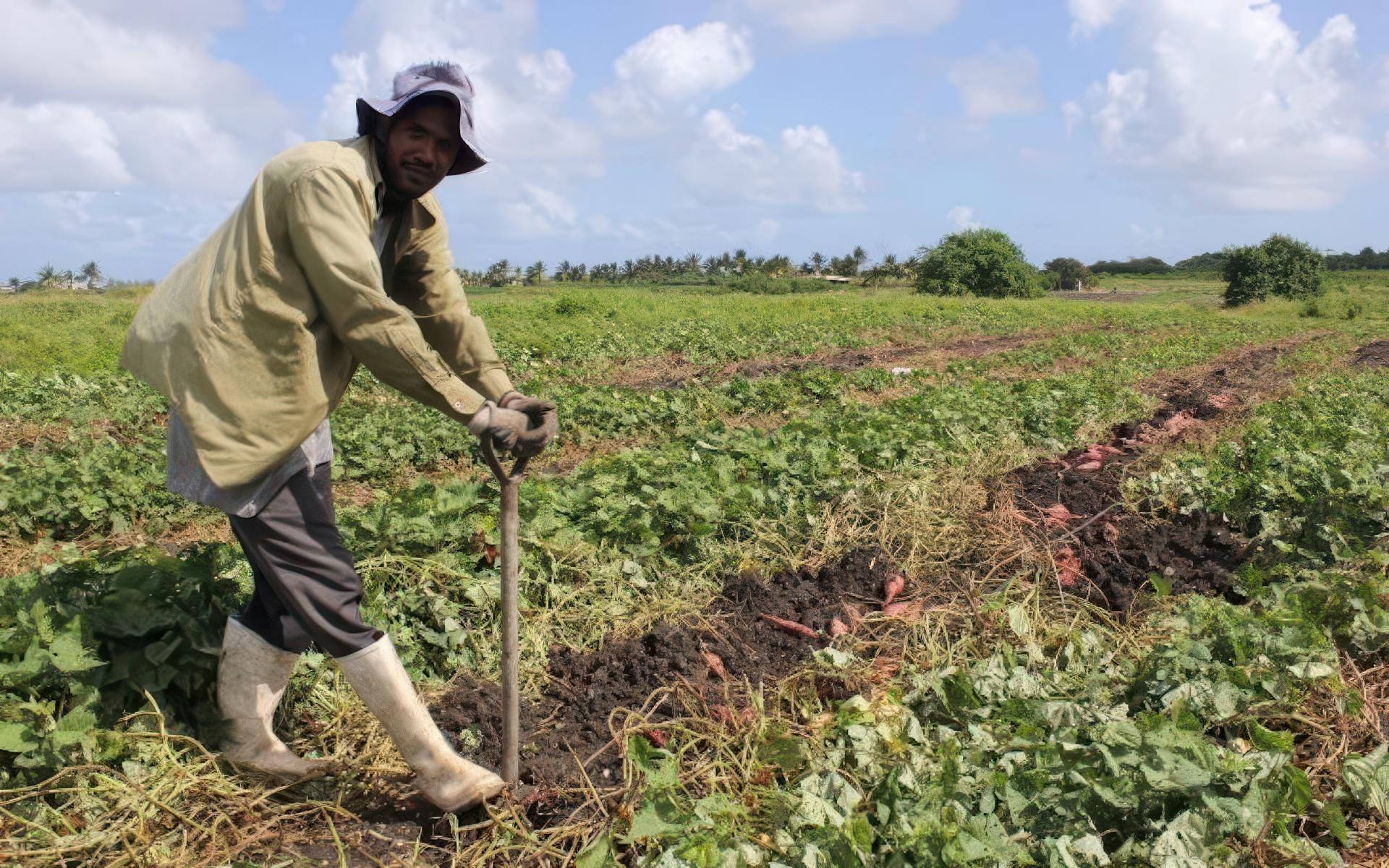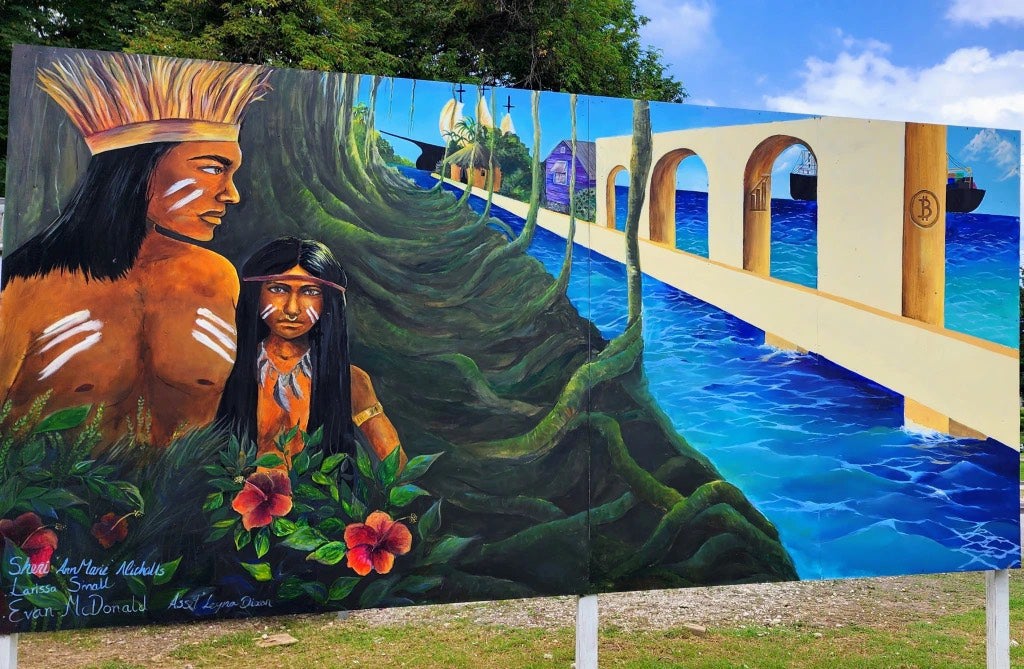
Para las naciones insulares como Barbados, donde los ritmos de la vida cotidiana están moldeados por las mareas y las lluvias, la resiliencia climática no es solo un objetivo: es una forma de vida arraigada en la sabiduría de la tierra y su gente. En la 16ª Conferencia de las Partes de la Convención de las Naciones Unidas de Lucha contra la Desertificación (UNCCD COP16), celebrada en Riad, Arabia Saudita, del 2 al 13 de diciembre de 2024, las naciones se reunieron para abordar algunos de los desafíos ambientales más apremiantes de nuestro tiempo. Para los pequeños Estados insulares en desarrollo como Barbados, hay mucho en juego. El cambio climático, la degradación de la tierra y la escasez de agua no son amenazas lejanas, son realidades cotidianas. Estas naciones necesitan reflexionar sobre soluciones innovadoras y fuerza colectiva. Al integrar el respeto por el patrimonio y el conocimiento Indígena con avances con visión de futuro, pueden liderar el camino hacia un futuro sostenible.
Como mujer Indígena urbana nacida y criada en Barbados, estoy profundamente conectada con la cultura y las tradiciones de esta isla, y al mismo tiempo honro la sabiduría de mi herencia Lokono-Arawak. Mi padre, que es barbadense y Lokono, y mi madre, Lokono y del territorio Pakuri de Guyana, me inculcaron un fuerte sentido de identidad que une ambos mundos. Al crecer en Barbados, me nutrí de la vitalidad de la vida caribeña y las enseñanzas de mi herencia Indígena, que dieron forma a mi comprensión de la resiliencia, la comunidad y la sostenibilidad. Esta mezcla de la vida moderna de Barbados y las antiguas tradiciones Indígenas ha dado forma a mi visión sobre la resiliencia y la sostenibilidad y demuestra que las soluciones que buscamos hoy están profundamente entrelazadas con la sabiduría del pasado y las innovaciones del presente. Al abrazar todas las partes de lo que somos, podemos navegar los desafíos de las crisis climáticas con fuerza y unidad, mostrándole al mundo el poder del equilibrio y la armonía.
Barbados, cariñosamente llamada "la joya del Mar Caribe", encarna un legado de resiliencia y colaboración. Un elemento central de este legado son las contribuciones de sus Pueblos Indígenas, cuyo profundo conocimiento de la tierra, perfeccionado durante más de 4.000 años, sentó las bases para las prácticas agrícolas de la isla. Los primeros pueblos de Barbados en la época de Colón eran los Lokono-Arawaks. En 1627, los miembros de esta nación tribal fueron contratados por los primeros colonos ingleses de Barbados para impartir su comprensión de cómo vivir en armonía con la tierra. Hasta 1630, guiaron a los colonos en la plantación de cultivos adecuados a tipos de suelo específicos; el suelo rojo con alto contenido de arcilla mal drenado, el suelo negro rico en nutrientes y bien drenado, y el suelo arenoso y pobre en nutrientes, donde solo la yuca podía prosperar. También enfatizaron la importancia de plantar cultivos en las épocas más favorables del año, como cuando el sistema estelar de las Pléyades se hizo visible en el cielo nocturno, señalando el inicio de la temporada de lluvias.

Agricultura barbadense. Foto cortesía de barbadosenvironment.org.
Estas primeras contribuciones agrícolas fueron transformadoras. Los Lokono-Arawaks introdujeron cultivos como la yuca, el maíz, las batatas, el tabaco, las piñas y la caña de azúcar, que obtuvieron de los colonos holandeses en Guyana en 1618. También compartieron prácticas agrícolas sostenibles (como la rotación de cultivos) para evitar el agotamiento del suelo. El maíz, los frijoles y las calabazas a menudo se plantaban juntos para que los frijoles crecieran en el tallo del maíz. Las grandes hojas de calabaza retenían la humedad del suelo y daban sombra al suelo, lo que permitía que las plantas se fertilizaran mutuamente. Este enfoque holístico mejoró la salud del suelo y aumentó los rendimientos, formando la base de la agricultura sostenible en la isla.
El conocimiento de los Lokono-Arawaks se extendió más allá de la tierra hasta el mar. A lo largo de los siglos, dominaron las técnicas para navegar por las mareas y los cambios estacionales, identificando las épocas más seguras del año para los viajes de larga distancia. Este conocimiento se volvió crucial no solo para el comercio, sino también para la resistencia. Durante los siglos XVII y XVIII, muchos africanos esclavizados utilizaron estas técnicas para escapar de Barbados a San Vicente y las Granadinas. Estos viajes solían tener lugar entre diciembre y abril, durante la estación seca que seguía al final de la temporada de huracanes. Hoy en día, los navegantes por placer continúan beneficiándose de esta sabiduría ancestral, que sigue siendo una parte vital del patrimonio cultural del Caribe.
En términos de conocimiento Indígena antiguo relacionado con el agua, observar el comportamiento de la vida silvestre nos ayuda a predecir las lluvias con una precisión asombrosa. La fragata vuela en círculos sobre la tierra cerca de la costa exactamente 15 minutos antes de que caiga la lluvia. De uno a tres días antes de las fuertes lluvias, las termitas macho pululan alrededor de las fuentes de luz de la casa por la noche. Siete días antes de la inundación, las hormigas que viven en el suelo construyen las entradas de lodo a sus nidos de varias pulgadas de altura. Y unos 15-30 minutos antes de que llegue un tsunami, las aves que anidan en la costa y los mamíferos costeros huyen tierra adentro, ofreciendo a los humanos la oportunidad de seguirlos a tierras más altas y salvar sus vidas.
Innovación basada en principios Indígenas
Barbados se encuentra entre las 15 naciones con mayor escasez de agua a nivel mundial, y depende en gran medida de los acuíferos alimentados por aguas lluvias. La antigua sabiduría Indígena proporciona información valiosa para abordar este desafío, y Barbados se está basando en este legado de antigua sabiduría Indígena para abordar el desafío crítico de la escasez de agua con tecnología moderna.
Aprovechar las capas freáticas subterráneas utilizando una serie de vasijas de barro sin fondo apiladas unas sobre otras para crear pozos de agua en la estación es un ejemplo de los antiguos principios de los Pueblos Indígenas de trabajar con los ciclos naturales para crear sistemas sostenibles. Combinando esta tecnología con una infraestructura mejorada, como la planta de aguas residuales de la Costa Sur que recicla las aguas residuales para el riego y la reposición de aguas subterráneas y las dos plantas de desalinización existentes, Barbados está construyendo un futuro en el que la escasez de agua ya no limite el crecimiento.
Las innovaciones modernas, como la iniciativa Eco Sky Water, están ayudando a abordar este problema crítico. Esta tecnología de energía solar extrae vapor de agua del aire, produciendo más de 1.000 litros de agua limpia y potable al día. La ampliación de estos sistemas a hogares, escuelas y granjas podría transformar el acceso al agua en toda la isla.
Esta misma armonía con los ciclos naturales guía las soluciones en la agricultura, donde la necesidad de prácticas resilientes al clima se vuelve más urgente cada año. Barbados dedica el 37% de su tierra a la agricultura, pero gran parte de ella sigue ligada a la producción de caña de azúcar, un legado colonial. La transición a una agricultura diversificada con cultivos resilientes al clima es esencial para fortalecer la seguridad alimentaria y reducir la dependencia de las importaciones.

El primer mural en Barbados en honor a los Primeros Pueblos de la isla.
Combinando el conocimiento agrícola tradicional con la ciencia moderna, los agricultores pueden cultivar cultivos adecuados a las condiciones cambiantes. Por ejemplo, el asocio de cultivos y la agroforestería inspirados en prácticas Indígenas pueden mejorar la salud del suelo y reducir la erosión. Los avicultores a pequeña escala, que luchan contra el estrés por calor debido al aumento de las temperaturas, necesitan acceso a infraestructuras asequibles como gallineros con sombra y sistemas de refrigeración eficientes en el uso del agua para mantener sus operaciones.
Los ecosistemas marinos son fundamentales para la cultura y la economía de Barbados, pero se enfrentan a crecientes amenazas como la sobrepesca, el blanqueamiento de los arrecifes de coral y la escorrentía de plaguicidas. El acuerdo de deuda por clima de Barbados está financiando la modernización de los sistemas de alcantarillado para reducir la contaminación de los océanos. Estos esfuerzos protegen la biodiversidad marina y garantizan los medios de vida de los pescadores que dependen del mar. El fortalecimiento de las prácticas de conservación y la promoción de métodos de pesca sostenibles son cruciales para preservar estos ecosistemas para las generaciones futuras.
Al adoptar soluciones basadas en la resiliencia, la colaboración y la innovación, los pequeños Estados insulares en desarrollo como Barbados pueden liderar el camino hacia el desarrollo sostenible. La intersección de la sabiduría ancestral y la ciencia de vanguardia ofrece poderosas oportunidades para abordar la escasez de agua, la seguridad alimentaria y la conservación marina. Pero no se trata solo de abordar el cambio climático. Se trata de transformar las vulnerabilidades en fortalezas, mostrando al mundo cómo el equilibrio y la sostenibilidad pueden prosperar en armonía.
Al honrar la sabiduría del pasado, podemos crear soluciones innovadoras que garanticen la resiliencia frente a los desafíos globales. Las respuestas que buscamos hoy radican en combinar las soluciones del pasado con las del presente; cada parte de nuestra historia, nuestra cultura y nuestro conocimiento importa. Al abrazar esta verdad, nuestras naciones tienen la oportunidad de inspirar la acción global con sus historias, soluciones y liderazgo.
Sabantho Aderi Corrie-Edghill es miembro Lokono-Arawak de la comunidad Indígena Autónoma del Territorio Tribal Pakuri en la Región 4, Guyana. Es activista de derechos Indígenas, proveedora de datos Indígenas, educadora de recuperación e ilustradora y autora de libros infantiles.
Foto superior: Proyecto de regeneración de corales. Fotografía cortesía de Barbados Environmental Conservation Trust
